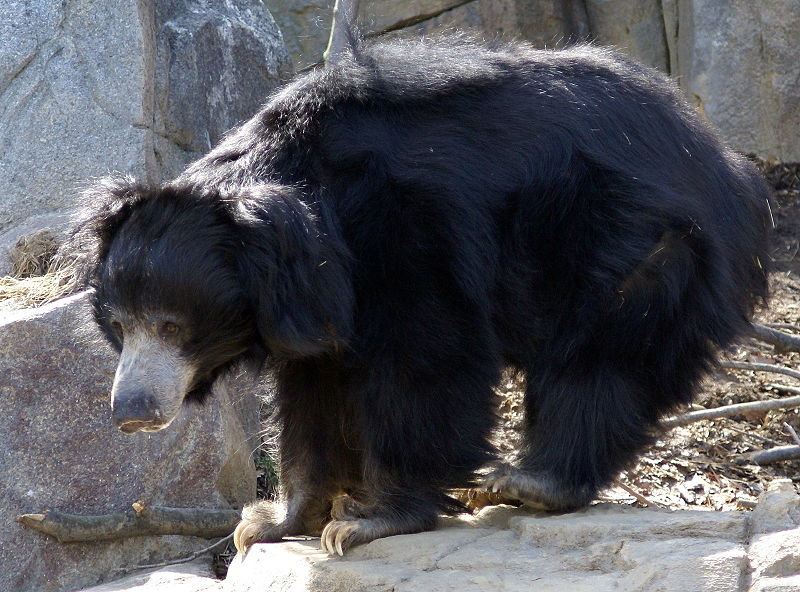|
Tami Nadu - Wildlife of Tamil Nadu - Sloth Bear of Tamil Nadu
Sloth Bear of Tamil Nadu
The Sloth Bear (Melursus ursinus), also known as the Labiated Bear, is an arboreal, nocturnal and insectivorous species of bear restricted to the Indian subcontinent. Tamil: Karadi
Naming and etymology
Originally, naturalists considered the sloth bear to be a species of sloth rather than a true bear. Because of this, the species has been renamed numerous times. After a sloth bear was taken to Europe for the first time in 1790, it was given the binomial name Bradypus pentadactylus, as well as the conventional names of "five fingered sloth", "sloth bear" and "ursine sloth". Meyer named the genus "melursus", while Fischer called it "chondrorychus". Shaw called it "Bradypus ursinus", while M. Blainville called it Ursus labiatus while Tiedemann called it Ursus longirostris. |
 |
Physical description
Sloth bears are distinguished from Asian black bears by their larger builds, longer, shaggier coat, pale muzzle and white claws Sloth bear muzzles are thick and long, with small jaws and bulbous snouts with wide nostrils. They have long lower lips which can be stretched over the outer edge of the nose, and lack upper incisors, thus allowing them to suck up large numbers of insects. The premolars and molars are smaller than in other bears, as they do not chew as much vegetation. In adults, the teeth are usually in poor condition, due to the amount of dirt they suck up and chew when feeding on insects The back of the palate is long and broad, as is typical in other ant-eating mammals. The paws are disproportionately large, and have highly developed, sickle shaped blunt claws which measure 4 inches in length. Their toe pads are connected by a hairless web.
They have the longest tail in the bear family, which can grow to 6-7 inches.[9] Their back legs are not very strong, though they are knee-jointed, and allow the sloth bear to assume almost any position. The ears are very large and floppy. Sloth bear fur is completely black (rusty for some specimens), save for a whitish Y or V shaped mark on the chest. This feature is sometimes absent, particularly in Sri Lankan specimens. This feature, which is also present in Asian black bears and sun bears, is thought to serve as a threat display, as all three species are sympatric with tigers. The coat is long, shaggy and unkempt, and is particularly heavy behind the neck and between the shoulders, forming a mane which can be 30 cm long. The belly and underlegs are almost bare. Adult sloth bears usually weigh 220 lbs, though they can rach up to 300 lbs. They are 2.3 feet high at the shoulder, and have a body length of 5-6 feet. Females are smaller than males, and have more fur between the shoulders.
Behaviour
Adult sloth bears may travel in pairs, with the males being gentle with cubs. They may fight for food. They walk in a slow, shambling motion, with their feet being set down in a noisy, flapping motion. They are capable of galloping faster than running humans. Although they appear slow and clumsy, sloth bears are excellent climbers. They climb to feed and rest, though not to escape enemies, as they prefer to stand their ground. They are capable of climing on smooth surfaces and hang upside down like sloths. They are good swimmers, and primarily enter water to play.
To mark their territory, sloth bears will scrape trees with their forepaws, and rub against them with their flanks. Sloth bears have a high vocal range. Gary Brown, in his Great Bear Almanac lists over 25 different sounds in 16 different contexts. Sounds such as barks, screams, grunts, roars, snarls, wickers, woofs and yelps are made when angered, threatening or when fighting. When hurt or afraid, they shriek, yowl or whimper. When feeding, sloth bears make loud huffing and sucking noises, which can be heard over 100 metres away. Sounds such as gurgling or humming are made by bears resting or sucking their paws. Sows will emit crooning sounds to their cubs. The species is the most vociferous when mating, and make loud, melodious calls when doing so. Sloth bears do not hibernate. They make their day beds out of broken branches in trees, and will rest in caves during the wet season. Sloth bears are the most nocturnal of bears, though sows become more active in daytime when with cubs.
|
